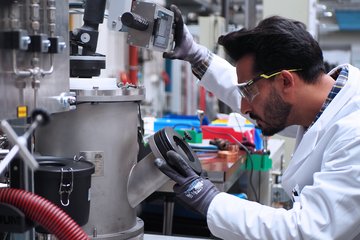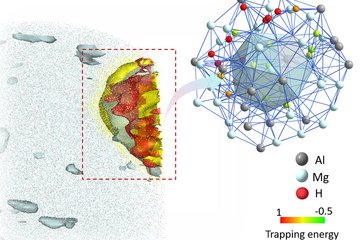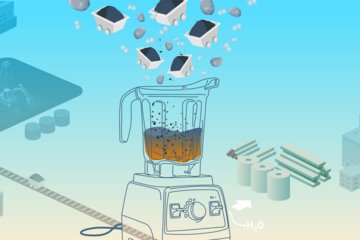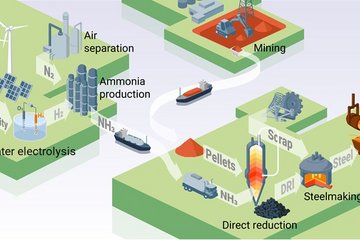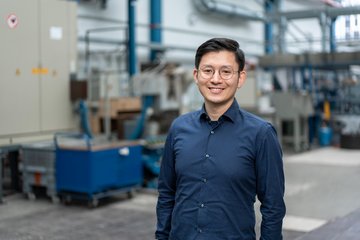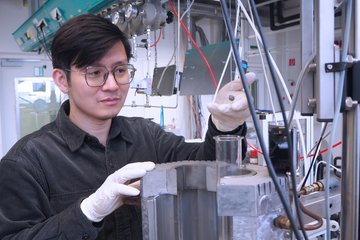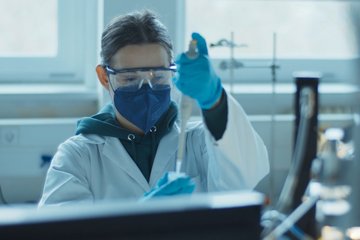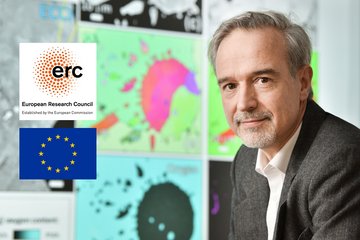Alle Typen
21.
Zeitschriftenartikel
The impedance-titrator: A novel setup to perform automated pH-dependent electrochemical experiments. Materials and Corrosion-Werkstoffe und Korrosion 60 (11), S. 855 - 858 (2009)
22.
Zeitschriftenartikel
Gold nanoparticles partially embedded in ultrathin anodic alumina films. The Journal of Physical Chemistry C 113 (8), S. 3105 - 3109 (2009)
23.
Zeitschriftenartikel
Electrocatalysis on gold nanostructures: Is the {110} facet more active than the {111} facet? Electrochem. Comm. 11, S. 2036 - 2039 (2009)
24.
Zeitschriftenartikel
Fabrication of single crystalline gold nanobelts. J. Mater. Chem. 19, S. 924 - 927 (2009)
25.
Zeitschriftenartikel
Electropolishing of a Nickel–Titanium–Copper Shape Memory Alloy in Methanolic Sulfuric Acid. Electrochemical and Solid-State Letters 12 (2), S. C1 - C4 (2009)
26.
Zeitschriftenartikel
Nanostructuring of NiAl–Mo eutectic alloys by selective phase dissolution. Electrochimica Acta 54, S. 6015 - 6021 (2009)
27.
Zeitschriftenartikel
Quantitative optical recognition of highly reproducible ultra thin oxide films in microelectrochemical anodisation. Rev. Sci Instrum. 80, S. 046106-1 - 046106-3 (2009)
28.
Zeitschriftenartikel
A combinatorial passivation study of Ta–Ti alloys. Corrosion Science 51, S. 1519 - 1527 (2009)
29.
Zeitschriftenartikel
High-throughput synthesis and characterization of anodic oxides on Nb–Ti alloys. Electrochimica Acta 54, S. 5973 - 5980 (2009)
30.
Zeitschriftenartikel
High throughput study of the anodic oxidation of Hf–Ti thin films. Electrochimica Acta 54, S. 5171 - 5178 (2009)
31.
Zeitschriftenartikel
Selective matrix dissolution in an Al–Si eutectic. Corrosion Science 51, S. 1490 - 1495 (2009)
32.
Zeitschriftenartikel
Spatial features control of self-organised tungsten nanowire arrays. Physica Status Solidi 206, S. 455 - 461 (2009)
33.
Zeitschriftenartikel
Single crystalline Molybdenum nanowires and nanowire arrays. J. Nanosci. Nanotechnol. 9 (6), S. 3411 - 3417(7) (2009)
34.
Zeitschriftenartikel
Growth of multioxide planar film with the nanoscale inner structure via anodizing Al/Ta layers on Si. Electrochim. Acta 54, S. 935 - 945 (2009)
35.
Zeitschriftenartikel
Selective surface oxidation and nitridation of NiTi shape memory alloys by reduction annealing. CoRR. Sci. 51, S. 635 - 641 (2009)
36.
Zeitschriftenartikel
Nanomechanics of rhenium wires: Elastic modulus, yield strength and strain hardening. Acta Materialia 57, S. 4032 - 4035 (2009)
37.
Zeitschriftenartikel
Structural characterisation of gold nanowire arrays. Journal of Crystal Growth 311 (1), S. 194 - 199 (2008)
38.
Zeitschriftenartikel
Passivity of a Nanostructured ds-NiAl–Re Alloy as Substrate for the Electrodeposition of Gold. Journal of the Electrochemical Society 155 (3), S. K31 - K37 (2008)
39.
Zeitschriftenartikel
Electrochemical Nucleation and Growth of Gold on Rhenium Nanowires. J. Electrochem. Plat. Technol. 1, S. 47 - 55 (2008)
40.
Zeitschriftenartikel
Arrays of Iso-Oriented Gold Nanobelts. Nano Lett. 8 (2), S. 737 - 742 (2008)
